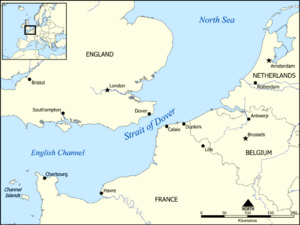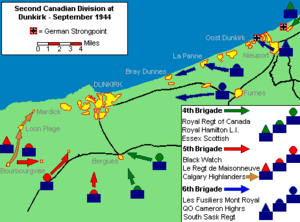Clearing the Channel Coast facts for kids
Quick facts for kids Clearing the Channel Coast |
|||||||
|---|---|---|---|---|---|---|---|
| Part of Siegfried Line Campaign | |||||||
 The Channel coast |
|||||||
|
|||||||
| Belligerents | |||||||
| Commanders and leaders | |||||||
| Units involved | |||||||
| Strength | |||||||
| 2 armoured divisions 4 infantry divisions |
3 divisions (in France) 2 divisions (in Holland) |
||||||
| Casualties and losses | |||||||
| 14,300 casualties | 13,100 killed, wounded, missing 70,971 captured Total: 84,071 casualties |
||||||
Clearing the Channel Coast was a big task for the First Canadian Army during World War II. It happened in August 1944, after the Allied forces had successfully landed in Operation Overlord (D-Day) and pushed out of Normandy, France.
The Canadian army moved from Normandy all the way to the Scheldt river in Belgium. Their main goals were to capture important Channel ports. These ports were needed to bring in supplies for the Allied armies. They also had to clear out German forces from the coast and destroy sites where Germany launched V-1 flying bombs. The German 15th Army tried to stop them but couldn't do much. They were worried about being surrounded by the fast-moving British Second Army. So, the Germans slowly retreated north-east towards the Scheldt.
On September 4, Adolf Hitler declared the Channel ports "fortresses," meaning they had to be defended at all costs. But Dieppe and Ostend were captured easily. Le Havre, Boulogne, and Calais needed big attacks after lots of bombing. An attack on Dunkirk was called off, and the German soldiers there were just kept surrounded. The troops who were surrounding Dunkirk were then sent to the Battle of the Scheldt. There, the First Canadian Army cleared the mouth of the Scheldt river, which opened up the important port of Antwerp for Allied ships.
Contents
Why This Was Important
From Normandy to the Seine River
German armies fought hard to stop the Allies from breaking out of Normandy. But when the German front lines collapsed in August, they didn't have enough soldiers or equipment. They also had no strong defense lines between Normandy and the Siegfried Line, which was Germany's main defensive line.
The British I Corps, which was part of the Canadian army, moved east along the coast. They faced some challenges like German flooding and defenses. But by August 16, German resistance weakened. The Canadians were given permission to advance fully on August 23.
General Bernard Montgomery, a top Allied commander, gave an order on August 26. He wanted all German forces in the Pas de Calais region of France and Flanders in Belgium to be destroyed. He also wanted Antwerp to be captured. The First Canadian Army had to cross the Seine river and capture Dieppe and Le Havre quickly. They also needed to secure the coast up to Bruges.
The German army was falling apart quickly. Just 15 days after the big battle at Falaise Pocket, Polish and Canadian units were already deep into Belgium. However, the Canadians still faced strong resistance. Hitler had ordered most Channel ports to be defended like fortresses. The Allies needed these ports for supplies. Also, the Germans had artillery near the coast that could shell Dover, England. They also had launch sites for V-1 flying bombs that were attacking London.
Getting Ready for Battle
Allied Forces
The First Canadian Army changed its makeup as needed. But generally, it included the II Canadian Corps and the I British Corps. At different times, soldiers from Czechoslovakia, Poland, France, the Netherlands, and Belgium also joined. After Normandy, some Polish and Czech soldiers who had been forced to join the German Army switched sides and joined the Allies.
The First Canadian Army had fought many tough battles in Normandy. This meant they had fewer commanders and soldiers. This was especially true for the infantry (foot soldiers). The I British Corps, which was attached to the Canadian Army, included several British divisions. These divisions had not done very well in Normandy. The 6th Airborne Division had landed on D-Day and fought bravely. It had many casualties, so its commander was told to harass the Germans but also save his men for future rebuilding. This division was joined by Belgian and Dutch units. These units were gaining experience before returning to their own countries.
The I British Corps advanced along the Channel coast, while the II Canadian Corps moved on their right, further inland.
German Forces
Much of the German Army Group B had been destroyed in Normandy and the Falaise Pocket. But some divisions east of the Allied landing areas were still mostly intact. The German troops defending the "fortress cities" were generally not their best soldiers. They included some Austrian and other nationalities who were not fully trusted.
Moving to the Seine River
The Canadian Army's push to the Seine was called Operation Paddle. Allied commanders hoped to trap the Germans against the Seine River and the sea, similar to the Falaise Pocket. The American Third Army tried to cut off the German escape routes. While many German vehicles and tanks were lost west of the Seine, they managed to save many soldiers and supplies by crossing the river.
German forces left towns along the River Touques around August 24. The capture of Lisieux opened an important route east. The next day, the River Risle was crossed. The 6th Airlanding Brigade captured Honfleur on the Seine estuary. However, progress along the coast was slower because rivers were wider and harder to cross. By August 30, all German units west of the Seine were cleared.
Crossing the Seine River
British patrols crossed the Seine on August 31. The advance had been so fast that the engineers didn't have enough bridging equipment ready. But new assault boats helped the 3rd Canadian Infantry Division cross the Seine at Elbeuf on August 27. Ferries for vehicles and tanks were ready later that day.
Cities Set Free
Dieppe
The Germans had left Dieppe before Hitler's order to defend it as a "fortress" arrived. The 2nd Canadian Infantry Division captured it on September 1. This was special because this division had been in Dieppe during the Dieppe Raid in 1942. A parade was held on September 5. Even though the port was damaged, it was cleared and ready for use by September 7. Oil and petrol were shipped from there to Brussels by September 9.
Le Havre
The I British Corps attacked Le Havre. They had special armored vehicles and support from land, sea, and air. It was captured on September 12 after 48 hours of fighting. However, the port needed a lot of work to clear debris and repair it.
Boulogne
Boulogne was reached on September 5. But the German soldiers there had received Hitler's "fortress" order. The city was protected by high ground. The 3rd Canadian Division attacked it with strong air and artillery support from September 17 to 22.
Rocket Launch Sites
On September 1, the last V-1 flying bomb was launched at London. This happened as the Canadians were moving through the areas where these rockets were launched.
Calais and Cap Gris Nez
Calais was surrounded in early September. Wissant was quickly captured, but an early attack on Cap Gris Nez failed. The main attack on Calais began on September 25, and the town fell on September 30. A second attack on the Cap Gris Nez batteries started on September 29 and was secured that same afternoon. Despite strong defenses, the German soldiers didn't fight to the very end.
Dunkirk
Dunkirk was reached by September 7. But it became clear that the German soldiers there would fight hard to hold the port, which was already mostly destroyed. The Allies decided it was better to use their soldiers and equipment to clear the Germans from the Scheldt estuary. This would open the port of Antwerp, which had been captured mostly intact. A smaller force was left to surround Dunkirk. The German garrison there finally surrendered on May 9, 1945, after the general German surrender. The 1st Czechoslovak Armoured Brigade surrounded Dunkirk, helped by Belgian and French Resistance members.
Belgium
Ostend was not on Hitler's list of "fortresses," so the Germans left it, even though it had strong defenses. The port was damaged. The 1st Polish Armoured Division crossed into Belgium and captured Ypres on September 6. They reached the Ghent–Bruges Canal on September 9.
Scheldt River
A long and difficult operation was needed to clear the Germans from both sides of the Scheldt river. This was crucial to open the Port of Antwerp for Allied shipping.
What Happened Next
Even though Dieppe was quickly put to use, it could only supply about a quarter of what the Allied armies needed. Capturing Le Havre, Boulogne, Calais, and Ostend helped with supplies only after a lot of work to clear debris and mines. Ostend was only used for people, not cargo. But the Boulogne terminal for a special oil pipeline called Pluto was very helpful. It became the main source of fuel for the Allies during the winter and spring campaigns. Some people wondered if capturing these heavily defended ports was worth the effort, given how much work they needed and how important Antwerp was.
After the failure of Operation Market Garden, the Allies focused on Antwerp. Even though other ports were captured later, Antwerp was the closest, largest, and best-preserved port. It was the key to solving the Allies' supply problems. Antwerp finally opened on November 29, 1944, after the Battle of the Scheldt was won. This largely solved the Allied supply issues.


